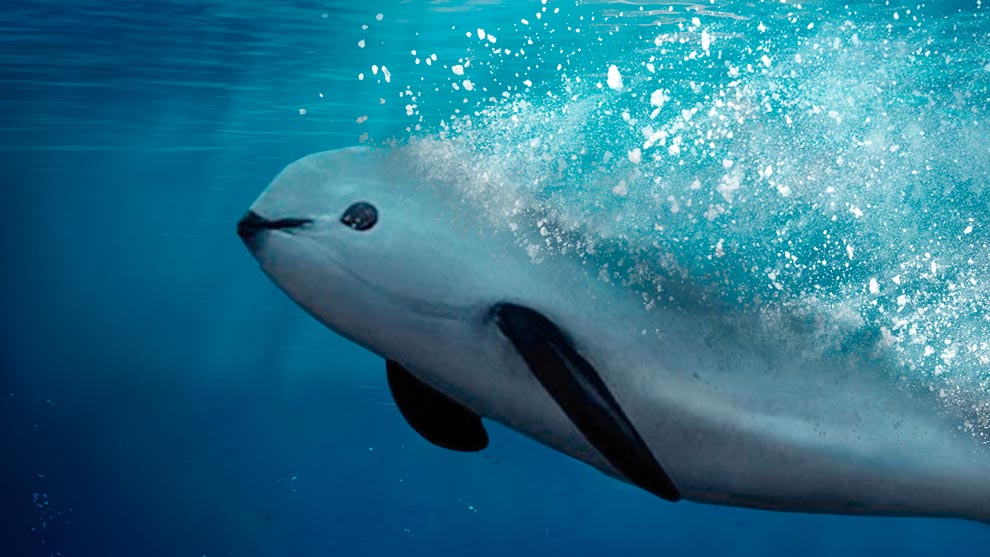Vaquita
Why in News: The world’s most endangered marine mammal, the vaquita, is teetering on the edge of extinction.

About Vaquita
The vaquita, scientifically known as Phocoena sinus, is the smallest member of the porpoise family and is known for its shy nature.
Endangered Status
- Vaquitas are the most critically endangered marine mammals globally, with fewer than 20 individuals remaining in the wild.
Distribution
- They inhabit the northern part of the Gulf of California, where the waters are abundant with fish and shrimp.
- Vaquitas are typically found in shallow waters up to 50 meters deep.
Physical Features
- Vaquitas are the smallest cetaceans, measuring between 4 to 5 feet (1.2 to 1.5 meters) in length and weighing 65 to 120 pounds (29.5 to 54.4 kg).
- They have chunky bodies, rounded heads without snouts, and sport a dark gray coloration with lighter gray undersides and distinctive black patches on their face.
- Their dorsal fins are unusually tall and wide compared to other porpoises, and they feature a dark ring around their eyes.
Behavior
- Known for their elusive behavior, vaquitas tend to avoid boats and human activity.
- They use echolocation, emitting high-frequency clicks for communication and navigation underwater.
Threats
- The decline in vaquita numbers is primarily attributed to illegal gillnets set for totoaba, a large fish endemic to the Gulf of California.
- Both vaquitas and totoabas are similar in size, making them unintentional victims of these gillnets.
Conservation Status
- Vaquitas are classified as Critically Endangered on the IUCN Red List, highlighting the urgent need for conservation efforts to protect this species.
Pangong Lake
Why in News: Based on satellite images, China’s military is gearing up for a prolonged presence in the vicinity of Pangong Lake in eastern Ladakh.

About Pangong Lake:
- Geographical Location and Name: Pangong Lake, known locally as Pangong Tso, is a high-altitude endorheic lake situated at approximately 4,350 meters (14,270 feet) above sea level in the Himalayas.
- Etymology: The name “Pangong Tso” originates from the Tibetan language, meaning “high grassland lake”.
- Altitude and Size: It is recognized as one of the world’s highest brackish water lakes, covering an area of 604 square kilometers. The lake stretches about 134 kilometers (83 miles) in length, with approximately 60% of its expanse lying within China’s territory.
- Proximity and Access: Located around 140 kilometers from Leh in Jammu and Kashmir, India, Pangong Lake extends across the India-China border.
- Physical Characteristics: Pangong Lake measures approximately 5 kilometers (3.1 miles) in width at its widest point. It is renowned for its remarkable color-changing waters, transitioning between shades of blue, red, and green.
- Seasonal Dynamics: Despite being saline, Pangong Lake freezes completely during the winter months.
- Hydrological Context: The lake is not part of the Indus River basin and constitutes a distinct, land-locked river basin.
- Geopolitical Status: Pangong Lake is situated in a disputed territory, with the Line of Actual Control (LAC) passing through it, marking the boundary between India and China.
Shree Jagannath Temple
Why in News: The committee led by a judge from the Orissa High Court has expedited the process of unlocking the treasure stored in the Ratna Bhandar of Shree Jagannath Temple after a 46-year hiatus.

- Location and Dedication: Shree Jagannath Temple is situated in Puri, Odisha, and is dedicated to Lord Jagannath, a manifestation of the Hindu deity Vishnu.
- Historical Background: Constructed during the rule of King Anantavarman Chodaganga Deva in the 12th century, the temple has deep historical roots under the Eastern Ganga dynasty.
- Architectural Style: The temple exemplifies Kalinga architecture, distinctive to the Odisha region, featuring intricate designs and structural grandeur.
- Temple Complex: The expansive complex includes shrines, gardens, and sacred tanks, fostering a tranquil environment for spiritual devotion.
- Main Sanctum: At its heart lies the sanctum sanctorum, known as garbhagriha, housing idols of Lord Jagannath, Balabhadra, and Subhadra.
- Symbolic Chakra: Crowned atop the temple is a towering 20-foot-high chakra (wheel), strategically positioned for visibility across the city.
- Ratha Yatra Festival: The temple is famed for the annual Ratha Yatra festival, marking Lord Jagannath’s ceremonial journey to Gundicha Temple via Mausi Maa Temple. This festival spans nine days starting in June–July.
- Religious Significance: Recognized as one of the Chaar Dhaams, the four principal pilgrimage sites in Hinduism, Shree Jagannath Temple holds profound religious importance.
- UNESCO Heritage Site: Acknowledged as a UNESCO World Heritage Site, the temple stands as a testament to India’s cultural and architectural heritage.
Kaziranga National Park
Why in News: The recent severe flood in Kaziranga National Park (KNP) in Assam has resulted in the unfortunate loss of 114 wild animals, with another 95 animals successfully rescued.

- Location: Kaziranga National Park is situated in the northeastern part of India, specifically in the districts of Golaghat and Nagaon in the state of Assam.
- Size and Significance: It is the largest undisturbed and representative area in the floodplain of the Brahmaputra Valley. Declared a National Park in 1974, it covers an expansive area of 400 square kilometers.
- Wildlife: Kaziranga is renowned for hosting the world’s largest population of one-horned rhinoceroses. It also supports a diverse array of mammals including tigers, elephants, panthers, bears, and a rich avian population with thousands of bird species.
- River and Landscape: The park is crisscrossed by the river Diffalu, a Brahmaputra tributary, and bordered to the south by the Moradifalu tributary. Its terrain features dense forests, tall elephant grass, rugged reeds, marshes, and shallow pools.
- Conservation and Recognition: Designated a UNESCO World Heritage Site in 1985, Kaziranga boasts a unique landscape dotted with dense elephant grass, swamplands adorned with water lilies, water hyacinths, and lotus flowers.
- Flora: The park is famous for its dense stands of elephant grass interspersed with small swamps. It also hosts a variety of aquatic plants such as water lilies and water hyacinths, along with significant vegetation like the rattan cane.
- Fauna: Kaziranga National Park is home to numerous endangered and threatened species including the one-horned rhinoceros, Bengal tiger, Eastern swamp deer, Asiatic elephant, wild water buffalo, Hoolock gibbon, Capped langur, and the Gangetic River dolphin.



